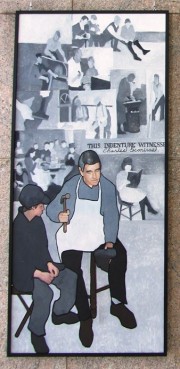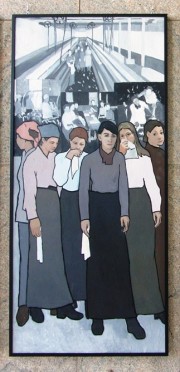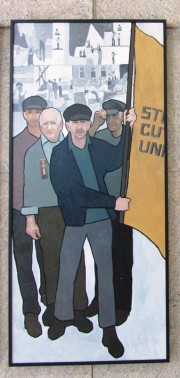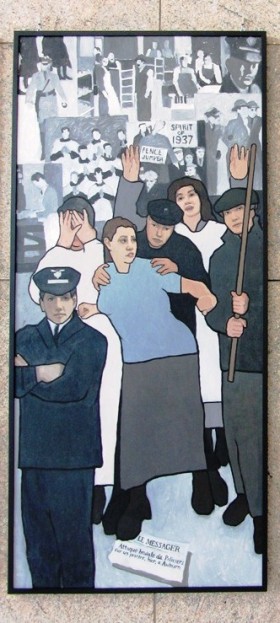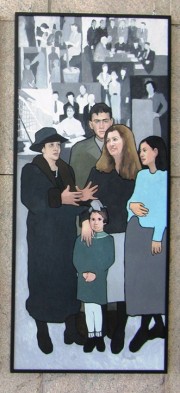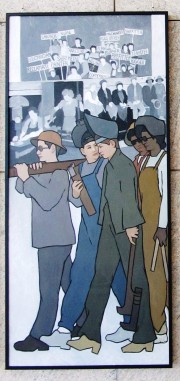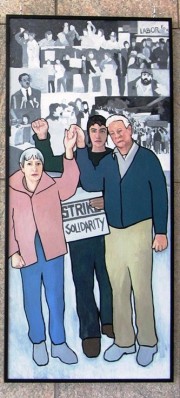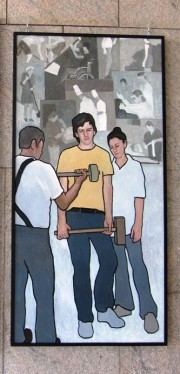People who have worked on farms, in forests, on the seas, in mills, factories and offices — all have contributed to the Maine economy over the past nearly four centuries. In the twenty-first century more people are working in commercial, health, electronic, financial and other services than ever before.
A perspective of where workers have served in the past should help citizens and decision-makers understand the context and the challenges of our current economy.
The Knights of Labor was a movement dedicated to expose abuses suffered by Maine workers, including working children. While the national organization was started in 1869, Maine’s chapter was launched in Portland in 1882. By 1886 it had nearly 20,000 members in 116 “assemblies” and had supported labor law reforms that carried into 1887.
The State of Maine Inspector of Factories, Workshops, Mines and Quarries reported in 1904 as follows:
Down to 1887, when our present system of labor laws were enacted, Maine had grown to quite extensive proportions as a manufacturing state. Labor system it had none, each manufacturer making his own rules relating to help, wages, and working hours, with the result that women and children of all ages and conditions were often huddled into unsanitary workrooms, days of all length, from ten hours to fifteen hours, were demanded of them the year through. . . . A spirit of unrest was moving the masses.1
The continued labor union movement helped to calm the “unrest” of the masses. Something similar was to appear during the Great Depression when the Roosevelt administration strengthened union rights to organize and introduced Social Security. According to some, these and other reforms saved capitalism in the United States from the “unrest” of the masses.
In 2011 Maine Governor LePage brought labor history to popular consciousness when he removed a mural, created by Judy Taylor, depicting Maine’s workers occupations through the years. The controversy that followed became what educators call “a teachable moment.” The mural finally went on display in the atrium of the State Cultural Building in Augusta, managed by the staff of the Maine State Museum.
— — — — — — — —
The Maine Labor History Mural
Original images and content copyright 1998-2013*
Judy Taylor Fine Art, Mount Desert Island, Maine
Panel 1 – APPRENTICESHIP
Apprenticeship has always provided opportunities for workers to learn a skilled trade on the job. At the center of this panel is a shoemaker teaching his craft to a young apprentice. Labor historian Charles Scontras (who was a shoe repairer in his youth) was selected as the model for the mentor shown in the picture to honor his years of service in education and history. Other scenes in this panel show apprenticeship in a variety of other trades, including hatmaking. The young woman reading represents the children who were often brought into apprentice workshops to read or play music to keep workers entertained as they performed their work.
Panel Two – CHILD LABOR
As recently as a century ago, children as young as eight worked long hours in dangerous work environments. This panel depicts young workers and the trades in which they labored. The centerpiece is a cluster of young workers. Two are carrying dinner pails to their jobs and one has bandages on her hands, which reflects the sacrifices children made in their work. Scenes in the background include images from blueberry harvests, food and fish processing, and textile mills. [NOTE: The Maine Progressive Party Platform of 1914 addressed the issue of child labor and other worker’s rights.]
Panel Three – WOMEN TEXTILE WORKERS
During the 19th and 20th centuries, Maine textile mills employed thousands of workers, mostly women. The women shown in the front of the picture are holding handkerchiefs, reflecting the poor air quality in the mills because of all the lint in the air. Women in the background scenes are shown picking rags, sewing, and operating the massive looms found in many Maine factories. [NOTE: See Status of Women 1892]
Panel Four – THE SECRET BALLOT
In 1891, legislation was enacted to provide citizens with the secret ballot. This political reform was intensely supported by workers; it offered them protection against intimidation by their employers and secured the integrity of the voting process for workers and the general citizenry. The panel represents the significance of the secret ballot for workers and depicts the act of placing votes in a ballot box. In the background are images of Maine industries such as corn canning and pipe fitting. The top scene depicts an Irish neighborhood in Portland.
Panel Five – FIRST LABOR DAY
This panel honors the historical significance of Labor Day, when workers paraded under the banners of their unions. The stonecutters and granite workers of Maine are depicted here with an historical Maine Granite Workers badge pinned to one of the worker’s shirts. In the background are representative scenes from Hall Quarry, Stonington, and Hallowell, a few of the sites in Maine where granite was quarried. [NOTE search “granite workers unions” for the formation dates of three unions.]
Panel Six – WOODS WORKERS
Maine’s plentiful forests have historically provided economic activity and jobs in the woods products industry. Shown in the foreground is a group of workers engaged in organizing activities of the International Workers of the World, (so called “Wobblies”) in the 1920s. In the background, scenes depict tree-felling, log-driving, sawing, and life in woods camps. Workers in the pictures are carrying the traditional tools and implements of Maine loggers, including a uniquely Maine invention, the peavey. [NOTE: The IWW was one of the targets of the Ku Klux Klan in Maine.]
Panel Seven – THE ‘37 SHOE STRIKE
With the support of organizers at the Congress of Industrial Organizers (CIO), thousands of Lewiston and Auburn workers walked out of shoe mills in 1937, seeking fair wages, shorter hours, and union recognition.
Despite federal laws protecting their right to organize, workers were beaten and jailed for marching or speaking at public meetings. The image at the front of the panel shows a confrontation between marchers and police, and a French language newspaper that reported on the brutality. Images in the back show scenes from the strike, including the arrest of organizers. Also pictured is Auburn Police Chief Harry Rowe, who sided with the manufacturers and brought in state police to stop the picketing workers. The choir image is shown as a reminder of the Catholic Church’s opposition to the strike. A local priest warned that the strikers would go to hell and threatened excommunication for anyone who participated in the labor dispute.
Panel Eight – LABOR REFORMERS
This panel honors the work of the political reformers of the first half of the 20th century. Pictured prominently at the front is Frances Perkins, Secretary of Labor under President Franklin D. Roosevelt. Under Perkins’ leadership, the Roosevelt administration enacted sweeping labor and social reforms that comprise the foundation of the labor law and social safety net that exists today. Background images show Roosevelt and his cabinet, the signing of legislation establishing the employment security law, worker advocate Rose Schneiderman, and First Lady Eleanor Roosevelt. On the far left section of the panel are images of women at work and the 1911 fire at the Triangle Shirtwaist Factory, which is regarded as one of the worst workplace accidents in U.S. history. This had a great impact on Frances Perkins who, as a young woman, witnessed the tragedy in New York City.
Panel Nine – ROSIE THE RIVETER
This panel honors the contributions of the thousands of Maine women who entered the workforce during World War II to help support the war effort. Pictured at the front are women workers who built Liberty Ships in South Portland shipyards in the 1940s. Scenes in the background depict the variety of occupations held by Maine’s own “Rosie the Riveters” during the war.
Panel Ten – JAY STRIKE
In June 1987, 1,200 workers at the International Paper mill in Jay walked out on strike to protest wage cuts and layoffs. In what became the longest strike in New England history, union members and supporters held out for 17 months in a struggle that divided the town and ultimately cost many workers their jobs. The center image shows people in the community rallying behind striking workers and represents the many generations that were affected by the strike. Background scenes show picket lines, worker rallies, and a food cupboard that was established to help workers and their families. Pictured also is civil rights activist Jesse Jackson, as well as Roland Sampson and Peter Kellman, advocates for local workers.
Panel Eleven – THE FUTURE OF MAINE LABOR
The Maine workforce is in a constant state of change. The figures at the center of this panel depict one generation handing a hammer, symbolizing the work of labor, to a younger generation. Background images depict the faces and labors of the future workforce, including both young and old, new immigrants, and people with disabilities. Although nobody knows for certain what work will be like fifty or a hundred years from today, the Maine Department of Labor will continue to work to ensure opportunities and protect workers so that our future may be better than the past.
___________________
*NOTES, links, references, and photos of the original panel have been provided by the Encyclopedia. Historian Charles A. Scontras also contributed to the text.
1 Scontras. Two Decades . . ., cited below, p. 5.
Additional resources
A Day’s Work: A Sampler of Historic Maine Photographs, 1860-1920. Annotated and compiled by W.H. Bunting. Gardiner, Me. Tilbury House; Portland, Me. Maine Preservation. 1997–c2000.
Evans, Dana, et al. An Analysis Of High-Demand, High-Wage Jobs In Maine. Augusta, Me. Center for Workforce Research and Information. Maine Department of Labor. 2008.
Maine. Blue Ribbon Commission to Examine Alternatives to the Workers’ Compensation System. Report of Blue Ribbon Commission to Examine Alternatives to the Workers’ Compensation System and to make recommendations concerning replacement of the present system. Augusta, Me. Maine State Legislature. 1992. [University of Maine. Fogler Library. Special Collections.]
Maine State Labor News The Official Newspaper Of The Maine State Federation Of Labor. [Microform] Augusta, Me. The Federation. 1940-1976 1976 [University of Maine. Fogler Library; Bangor Public Library]
Scontras, Charles A. Collective Efforts among Maine Workers: Beginnings and Foundations, 1820-1880. Orono, Me.Bureau of Labor Education. University of Maine. c1994.
Scontras, Charles A. Labor Day – 2007: Pausing to reflect on images of Maine labor one hundred years ago. Orono, Me. University of Maine. 2007.
Scontras, Charles A. Labor in Maine: Building the Arsenal of Democracy and Resisting Reaction at Home, 1939-1952. Orono, Me. Bureau of Labor Education. 2006.
Scontras, Charles A. Time-line of Selected Highlights of Maine Labor History: 1636-2003. Orono, Me. University of Maine. Bureau of Labor Education. c2003.
Scontras, Charles A. Two Decades of Organized Labor and Labor Politics in Maine 1880-1900. Orono, Me. University of Maine. Bureau of Labor Education. 1969.
State of Maine. Department of Labor. Periodic reports on the labor force, women and minorities, etc.


